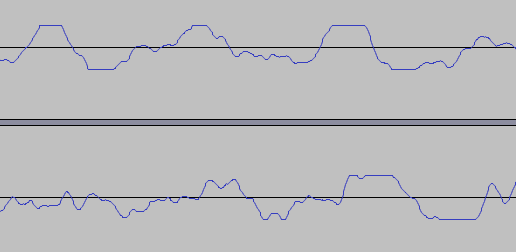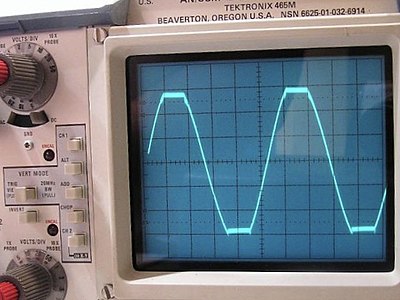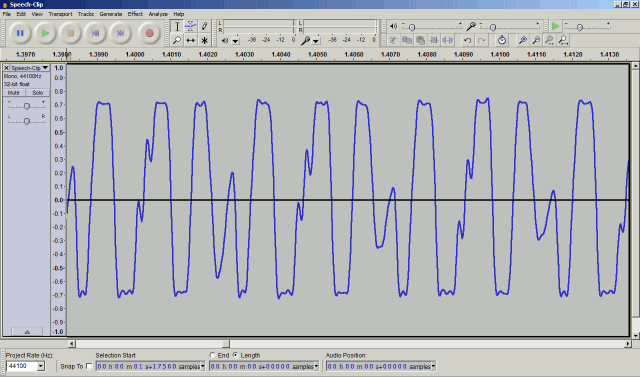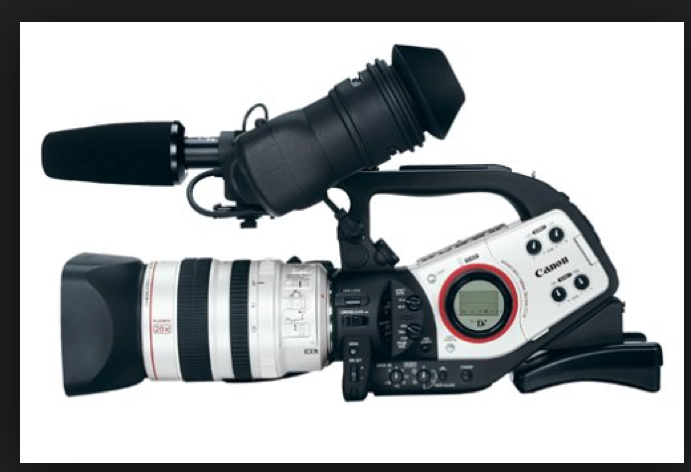So my church is trying to show this video, which is overall good quality (video wise) but the audio is horrible! It sounds ‘fuzzy,’ almost like the mic volume was maxed out or something… not quite sure how to explain it… the audio just sounds horrible, especially over huge speakers in our church (when we tested out the video live). I’ve gone through numerous posts on ‘cleaning up the audio,’ eq’ing, using different settings/filters/etc, but my results aren’t much better… attached is a clip of what I am working with. PLEASE, if anyone can help me out in making this sound some-what better, it would be very much appreciated. At it’s current level of quality, over large speakers it gets hard to even understand what he’s saying… and yes, I’ve looked for other versions/clips of the video, but this is the only version out there… I’m stuck.
Speech-Clip.zip (652 KB)
The audio is clipped, very badly, and was clipped before it got to Audacity. It looks like digital clipping. What was the audio chain?
The Clip Fix effect would be able to help with this, except that in many cases the clipping is so bad that you get the “reverse polarity” effect during the clipping, like this:

This is a portion of your audio clip, amplified to maximum for visibility. The blue area is “normal” digital clipping. The red areas are “reverse polarity” clipping. There’s not much you can so with it.
That said, you can try this recipe and see if it sounds any better to you:
- Make sure you are in 32-bit float
- Amplify with new peak amplitude -6
- Apply Clip Fix with threshold 50%
- Amplify - accept defaults
This will fix most of the “normal” clipping, but will fail on the “reverse polarity” clipping. You could then try the Repair effect on every individual case of reserve-polarity clipping, but that could take days.
– Bill
By “Clipping” Bill means the sound got louder than the system could handle. In your case very seriously loud. When you record badly overloaded audio, the normal lumps and bumps in the sound waves look like they were surgically removed top and bottom. Clipped off.
There is no way to rescue that kind of damage. There are tiny portions of the show where there just isn’t any voice or music any more. There’s nothing to rescue.
You need to find out what’s doing that before you make another recording. Koz

IMO it’s “limiting” rather than “clipping”, due to AGC which is probably incorporated into the video camera.
If it were true clipping the clipped peaks and troughs of the waveform would be completely flat : ruler-straight horizontal lines without any ripples …

True Clipping [ from Wikipedia ]

“Speech-Clip” has ripples in the flattened peaks and troughs, so it’s limiting not clipping.
It may be possible to defeat the AGC in the camera even if it can’t be swiched off.
Just a reminder that Steve does have an “experimental” ESP version of Clip Fix that tries to cope with inverted polarity http://audionyq.com/?download=ESP-ClipFix . To install Nyquist Plug-ins see Missing features - Audacity Support .
ESP Clip Fix needs a mono track, so to try it on this track, choose Tracks > Stereo Track to Mono (this audio appears to be almost the same in left and right channel in any case).
ESP Clip Fix seems to give a slightly better result than Clip Fix, 60% worked best for me. It now sounds much clearer (except for the clipping) rather than generally fuzzy.
Gale
but don’t expect miracles Frien004. That audio is very badly damaged - about 50% of the audio signal is missing (clipped off because the recording level was way too high) and the best that any type of repair can do is to try and guess what the missing parts of the waveform should have been like.
Another note. Most cameras have no provision for external audio and those that do have connections for tiny, delicate microphone signals, not powerful line level from a mixer. Only the very high-end cameras have connections and switching for everything. So that’s probably where your damage came from.
I’m remembering our Canon XL1 would do that and I think the XL2 would do that, too. Both obsolete standard def cameras, but high end when they were made.
This is also a call for wearing headphones for local camera monitoring while you’re making a recording. This show would never have gotten past the first few seconds if the operator could hear what was going on.
Koz

Thanks for all the tips everyone… I’m currently playing around with the “experimental” ESP version of Clip Fix (thanks Gale Andrews), but I’ve found that I can only do very small clips at a time, otherwise the program bugs out and crashes ![]() otherwise, I’m playing around with the settings first mentioned earlier in the thread by billw58… thanks again guys, hopefully I can come up with something SOMEWHAT better than what I currently have… and no, I didn’t record the audio
otherwise, I’m playing around with the settings first mentioned earlier in the thread by billw58… thanks again guys, hopefully I can come up with something SOMEWHAT better than what I currently have… and no, I didn’t record the audio ![]() I would have tested the equipment/levels before hitting the record button
I would have tested the equipment/levels before hitting the record button ![]() hahah… Cheers guys.
hahah… Cheers guys.
This may be where you press the perception elves into service. Apply regular Clip Fix to the whole show, reduce the level a little bit and send it back with a note. “I made it better, but it’s still fuzzy. I think it’s the best we can do.”
Nobody is going to do a direct comparison test and you will be off the hook.
The best you can do with a show that has damage like this is trade damages. As in my post, there are portions of the show with no singing or voice. It’s hard to recover from that. You will never get to Mormon Tabernacle grade shows with this performance. The programmer elves are using this as an excuse to work on the clip fix tools with a live, motivated tester. That would be you. Get fresh coffee.
On the video forums, we would be recommending the “Reshoot Filter.” Take the camcorder out and shoot it again.
People are horrified that sometimes the grownups have to do this as well. “We needed to stop cutting the film while a second unit went out and shot more footage.”
Koz